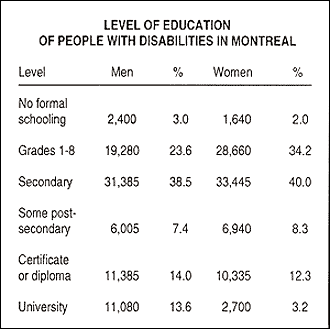|
Other barriers that women with disabilities face stem from sexism experienced by all women in the academic world. A recent report entitled Women in Canada shows that during the last two decades there bas been an increase in attainment of university degrees by women but still significantly fewer than men.4 What does this mean for women with disabilities? They face, on the one band, discrimination due to lack of access and, on the other, a male oriented structure that creates further inequity. The small percentage difference between men and women with disabilities who attain university degrees (approximately .6%) changes when looking at the area of employment. The 1994 Employment Equity Act annual report estimated that average salary of men with disabilities working full time was $45,063 and that of women with disabilities was $32,493 for those who had been hired under the Employment Equity legislation5 There appear to be unaccounted variables for the unequal salary distributions between men and women with disabilities. Thus, inequities between men and women with disabilities are perennial and present in many socio-economic areas. Current Climate Two factors further impede progress for women with disabilities in their struggle for academic equity. First is the historical period in which their current socio-economic struggle is taking place. The present struggle for social change by women with disabilities bas been compared to the feminist struggle of the fifties and sixties.6 The above data on the gap in attainment of university degrees between non- disabled women and women with disabilities supports this analysis. This suggests that, like their non-disabled sisters, women with disabilities may have other obstacles to overcome-such as economics, individual disability-specific barriers, etc.-before they can tackle the academic ones. 
As well, people whose on set of disability came during childhood and who were students between 1940 and 1980 received their elementary education, for the most part, in segregated schools. The quality of that education was minimal. It served as a means for limiting most from achieving higher education. Among those who succeeded to higher education, the majority did so in fields that are, today, under-employing, such as liberal arts, social services and the like. The second factor comprises the changing social and industrial economies. We are getting a clear message from all levels of government that there is an "economic countercurrent" to social change at this time. Non-disabled women are said to have made strictest in obtaining university degrees in the last two decades during which time the economy was "favorable to social change." However, it is becoming progressively unfavorable and we can predict that in the next two decades social change will be more difficult to achieve.
When looking at disabilities, the state of the economy is crucial. One needs only to recall that accessibility requires expenditure. Even in what were supposed to be the good times, securing appropriate financial assistance to render environments accessible bas not been easy. To achieve the same results as their non-disabled sisters in the area of academic, women with disabilities will need to be singularly focused on this goal. Education rather than employment would need to be a priority for organizations of women with disabilities. |
| Back | Contents | Next |